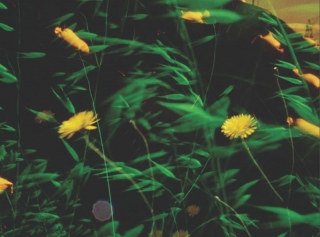Date: 20 October 2012 | Season: London Film Festival 2012 | Tags: London Film Festival
NATHANIEL DORSKY & JEROME HILER
Saturday 20 October 2012, at 2pm
London BFI Southbank NFT 3
While others bemoan the end of celluloid, Nathaniel Dorsky – whose work has become an annual highlight of the festival over the past decade – continues apace, more productive now than ever. His carefully considered practice has this year created works of great beauty from a period of sorrow. This screening of two new films will be complemented by rarely exhibited work by his companion Jerome Hiler.
Nathaniel Dorsky, August and After, USA, 2012, 19 min
‘After a lifetime, two mutual friends, George Kuchar and Carla Liss, passed away during the same period of time.’ (ND)
Nathaniel Dorsky, April, USA, 2012, 26 min
‘Following a period of trauma and grief, the world around me once again declared itself in the form of one of the loveliest springs I can ever remember in San Francisco. April is intended as a companion piece for August and After, and is partly funded by a gift from Carla Liss.’ (ND)
Jerome Hiler, Words of Mercury, USA, 2011, 25 min
Jerome Hiler, who shares Dorsky’s heightened sense of wonder at the world around him, builds sensuous layers of superimposition at the moment of shooting. A most private filmmaker, whose primary craft is the less transient medium of stained glass, he has until recently only shown his work as camera originals, thus limiting their public visibility. His inclusion in the latest Whitney Biennial prompted this first digital transfer.
PROGRAMME NOTES
NATHANIEL DORSKY & JEROME HILER
Saturday 20 October 2012, at 2pm
London BFI Southbank NFT 3
AUGUST AND AFTER
Nathaniel Dorsky, USA, 2012, 16mm, colour, silent, 19 min
Nathaniel Dorsky’s August and After is dedicated to two recently departed friends, legendary filmmaker George Kuchar and actress Carla Liss. The film shows them vibrantly, resiliently alive shortly before their passing and then sets off in search of soothing beauty, yielding searing images awash in colours both belonging to and transcending our natural world. Well into the twilight years of 16mm filmmaking, Dorsky continues to present textures and hues that are indispensible to the art of cinema. We will be poorer without them. (Andréa Picard)
www.nathanieldorsky.net
APRIL
Nathaniel Dorsky, USA, 2012, 16mm, colour, silent, 26 min
In my filmmaking I came upon the idea that if I began to arrange images in a certain way, it could transform the ego instead of confirming it. In other words, if you put two shots together to create a solid concept – this is happening, characters getting out of a car and walking down the street, or someone sitting at a window looking – you construct a series of images in such a way that you nurture ego, but then disrupt it through the montage. When you cut to the next shot, there might be a reemergence of presence, but it wouldn’t be a daisy chain back to the previous image, so it wouldn’t solidify the ego. There might be a way of using montage to realize the wisdom of what cinema has to offer. Cinema has great, great wisdom, and it’s very seldom used as a wisdom medium. In a sense, you can nurture the heart in a montage, going from one thing to the next in a way that touches the heart’s intelligence. You can use the energy of the cinema to transform the viewer by letting the viewer rediscover themselves at each moment in the present. (Nathaniel Dorsky interviewed by Ari Spool)
www.nathanieldorsky.net
WORDS OF MERCURY
Jerome Hiler, USA, 2011, video, colour, silent, 25 min
At the very end of ‘Love’s Labour Lost’, as the cast is frolicking around, a messenger comes in to announce a death which brings a sudden shift to the very end of the play. One of the most comical characters, now newly sober, ends the play with a quick dismissal of the audience: ‘The words of Mercury are harsh after the songs of Apollo. You that way – we this way.’Words of Mercury is, if nothing else, economical. It was shot on reversal film and its layers of superimpositions were all shot in the camera. Half of the many fades in the film were made by submerging the original film in a black liquid. The film is silent. The shooting ratio is low and there are areas which are unedited since taken from the camera. I generally shoot first and ask questions later, but I’m struck at the influences that I see in Words of Mercury because they reach back to the very first times that I saw great 16mm films in the early Sixties: Marie Menken, Gregory Markopolous, Stan Brakhage and my lifetime companion Nathaniel Dorsky. (Jerome Hiler)
Back to top
